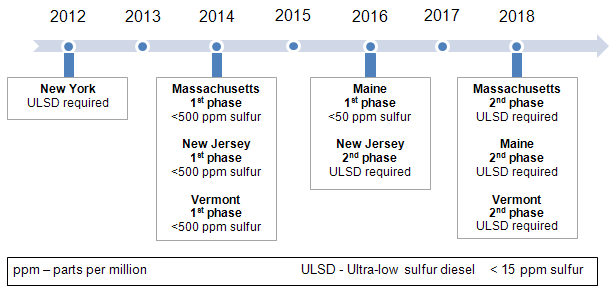
Sulfur content of heating oil to be reduced in northeastern states

Notes: New York and New Jersey regulations take effect in July of the year shown, and regulations in Maine take effect in January. The Massachusetts Department of Environmental Protection issued a commitment in their State Implementation Plan. The New Jersey Department of Environmental Protection proposed a one-year extension of the deadline for meeting Phase I limits of 500 ppm sulfur. Adopting this proposal would make Phase I limits effective July 2015. Under this proposal the 2016 Phase 2 deadline requiring ULSD would remain intact.
Heating oil is a type of distillate fuel used mostly in the Northeastern U.S. for space heating during the winter months. Starting this summer, the state of New York will require that all heating oil used in the state contain less than 15 parts per million sulfur—the same requirement as on-road ultra-low sulfur diesel (ULSD). Soon, other states in the Northeast will require reductions in heating oil sulfur content as well (see figure above).
In late 2010, EIA detailed upcoming changes to heating oil sulfur content limits in the Northeast heating oil market. Since then, some changes have occurred; for example, Massachusetts established sulfur limits for heating oil in their Regional Haze State Implementation Plan, Pennsylvania delayed some sulfur proposals, and New Jersey proposed to delay the initial introduction of its sulfur reduction timeline. Also, the Northeast Home Heating Oil Reserve has switched to ULSD.
The Northeast is the largest regional consumer of heating oil in the United States. However, heating oil consumption has been declining in the Northeast as it loses market share primarily to natural gas and as homeowners increase conservation and efficiency measures. The pattern of heating oil consumption is different from other fuels in the petroleum markets because of its strong seasonality. Consumption varies considerably with weather, and can almost quadruple from the summer lows to the winter peak months.
Where the ultra-low sulfur heating oil will come from is yet to be determined. In 2011, Northeast refineries supplied about 61% of ULSD consumed in the Northeast, net receipts from other regions supplied close to 28%, and net imports supplied about 10%. With two Northeast refineries and a Caribbean export refinery closed, the Northeast will likely depend on the Gulf Coast and imports from other countries to provide ultra-low sulfur heating oil. The Northeast exported some ULSD in 2011; those volumes can be expected to be absorbed into the local supply pool if price differentials do not support exports.
The new limit on sulfur content in heating oil sold in New York has several implications for the ULSD market. The volumes are sizable. Heating oil consumption in New York has averaged around 70,000 bbl/d on an annual basis, while ULSD consumption in the entire Northeast was about 360,000 bbl/d in 2011. The switch will increase ULSD consumption in the Northeast by about 20% and, in addition, will add a stronger seasonal component to the ULSD market. For a summary of the other changes likely to affect the East Coast, see "What's changing in East Coast Fuels markets?".
Tags: consumption/demand, diesel, heating oil, Maine, Massachusetts, New Jersey, New York, Pennsylvania, refining, states, Vermont